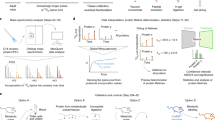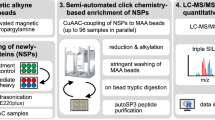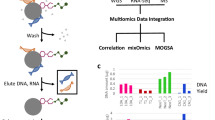Abstract
We describe a protocol for multiplexed proteomic analysis using neutron-encoded (NeuCode) stable isotope labeling of amino acids in cells (SILAC) or mice (SILAM). This method currently enables simultaneous comparison of up to nine treatment and control proteomes. Another important advantage over traditional SILAC/SILAM is that shorter labeling times are required. Exploiting the small mass differences that correspond to subtle differences in the neutron-binding energies of different isotopes, the amino acids used in NeuCode SILAC/SILAM differ in mass by just a few milliDaltons. Isotopologs of lysine are introduced into cells or mammals, via the culture medium or diet, respectively, to metabolically label the proteome. Labeling time is ∼2 weeks for cultured cells and 3–4 weeks for mammals. The proteins are then extracted, relevant samples are combined, and these are enzymatically digested with lysyl endopeptidase (Lys-C). The resultant peptides are chromatographically separated and then mass analyzed. During mass spectrometry (MS) data acquisition, high-resolution MS1 spectra (≥240,000 resolving power at m/z = 400) reveal the embedded isotopic signatures, enabling relative quantification, while tandem mass spectra, collected at lower resolutions, provide peptide identities. Both types of spectra are processed using NeuCode-enabled MaxQuant software. In total, the approximate completion time for the protocol is 3–5 weeks.
This is a preview of subscription content, access via your institution
Access options
Access Nature and 54 other Nature Portfolio journals
Get Nature+, our best-value online-access subscription
$29.99 / 30 days
cancel any time
Subscribe to this journal
Receive 12 print issues and online access
$259.00 per year
only $21.58 per issue
Buy this article
- Purchase on Springer Link
- Instant access to full article PDF
Prices may be subject to local taxes which are calculated during checkout






Similar content being viewed by others
References
Aebersold, R. & Mann, M. Mass spectrometry-based proteomics. Nature 422, 198–207 (2003).
Bantscheff, M., Schirle, M., Sweetman, G., Rick, J. & Kuster, B. Quantitative mass spectrometry in proteomics: a critical review. Anal. Bioanal. Chem. 389, 1017–1031 (2007).
Cox, J. et al. Accurate proteome-wide label-free quantification by delayed normalization and maximal peptide ratio extraction, termed MaxLFQ. Mol. Cell. Proteomics 13, 2513–2526 (2014).
Hebert, A.S. et al. Neutron-encoded mass signatures for multiplexed proteome quantification. Nat. Methods 10, 332–334 (2013).
Ross, P.L. et al. Multiplexed protein quantitation in Saccharomyces cerevisiae using amine-reactive isobaric tagging reagents. Mol. Cell. Proteomics 3, 1154–1169 (2004).
Thompson, A. et al. Tandem mass tags: a novel quantification strategy for comparative analysis of complex protein mixtures by MS/MS. Anal. Chem. 75, 1895–1904 (2003).
Hsu, J.L., Huang, S.Y., Shiea, J.T., Huang, W.Y. & Chen, S.H. Beyond quantitative proteomics: signal enhancement of the a1 ion as a mass tag for peptide sequencing using dimethyl labeling. J. Proteome Res. 4, 101–108 (2005).
Boersema, P.J., Raijmakers, R., Lemeer, S., Mohammed, S. & Heck, A.J. Multiplex peptide stable isotope dimethyl labeling for quantitative proteomics. Nat. Protoc. 4, 484–494 (2009).
Ong, S.E. & Mann, M. A practical recipe for stable isotope labeling by amino acids in cell culture (SILAC). Nat. Protoc. 1, 2650–2660 (2006).
Ong, S.E. et al. Stable isotope labeling by amino acids in cell culture, SILAC, as a simple and accurate approach to expression proteomics. Mol. Cell. Proteomics 1, 376–386 (2002).
Merrill, A.E. et al. NeuCode labels for relative protein quantification. Mol. Cell. Proteomics 13, 2503–2512 (2014).
Sleno, L. The use of mass defect in modern mass spectrometry. J. Mass Spectrom. 47, 226–236 (2012).
Gu, S., Pan, S., Bradbury, E.M. & Chen, X. Precise peptide sequencing and protein quantification in the human proteome through in vivo lysine-specific mass tagging. J. Am. Soc. Mass Spectrom. 14, 1–7 (2003).
Jekel, P.A., Weijer, W.J. & Beintema, J.J. Use of endoproteinase Lys-C from Lysobacter enzymogenes in protein sequence analysis. Anal. Biochem. 134, 347–354 (1983).
Denisov, E., Damoc, E., Lange, O. & Makarov, A. Orbitrap mass spectrometry with resolving powers above 1,000,000. Int. J. Mass Spectrom. 325–327, 80–85 (2012).
Harsha, H.C., Molina, H. & Pandey, A. Quantitative proteomics using stable isotope labeling with amino acids in cell culture. Nat. Protoc. 3, 505–516 (2008).
Geiger, T. et al. Use of stable isotope labeling by amino acids in cell culture as a spike-in standard in quantitative proteomics. Nat. Protoc. 6, 147–157 (2011).
Cox, J. & Mann, M. MaxQuant enables high peptide identification rates, individualized p.p.b.-range mass accuracies and proteome-wide protein quantification. Nat. Biotechnol. 26, 1367–1372 (2008).
Minogue, C.E. et al. Multiplexed quantification for data-independent acquisition. Anal. Chem. 87, 2570–2575 (2015).
Rhoads, T.W. et al. NeuCode labeling in nematodes: proteomic and phosphoproteomic impact of ascaroside treatment in Caenorhabditis elegans. Mol. Cell. Proteomics 14, 2922–2935 (2015).
Baughman, J.M. et al. NeuCode proteomics reveals Bap1 regulation of metabolism. Cell Rep. 16, 583–595 (2016).
Shishkova, E., Hebert, A.S. & Coon, J.J. Now, more than ever, proteomics needs better chromatography. Cell Syst. 3, 321–324 (2016).
Schütz, W. et al. Extending SILAC to proteomics of plant cell lines. Plant Cell. 23, 1701–1705 (2011).
Kruger, M. et al. SILAC mouse for quantitative proteomics uncovers kindlin-3 as an essential factor for red blood cell function. Cell 134, 353–364 (2008).
Potts, G.K. et al. Neucode labels for multiplexed, absolute protein quantification. Anal. Chem. 88, 3295–3303 (2016).
Rhoads, T.W. et al. Neutron-encoded mass signatures for quantitative top-down proteomics. Anal. Chem. 86, 2314–2319 (2014).
Shortreed, M.R. et al. Elucidating proteoform families from proteoform intact-mass and lysine-count measurements. J. Proteome Res. 15, 1213–1221 (2016).
Richards, A.L. et al. One-hour proteome analysis in yeast. Nat. Protoc. 10, 701–714 (2015).
Cox, J. et al. A practical guide to the MaxQuant computational platform for SILAC-based quantitative proteomics. Nat. Protoc. 4, 698–705 (2009).
Gorshkov, M.V., Fornelli, L. & Tsybin, Y.O. Observation of ion coalescence in Orbitrap Fourier transform mass spectrometry. Rapid Commun. Mass Spectrom. 26, 1711–1717 (2012).
Werner, T. et al. Ion coalescence of neutron encoded TMT 10-plex reporter ions. Anal. Chem. 86, 3594–3601 (2014).
Acknowledgements
We are grateful to M. Rush for comments during the writing process. This work was supported by the National Institutes of Health (P41 GM108538). K.A.O. gratefully acknowledges the support from a US National Library of Medicine training grant (5T15LM007359).
Author information
Authors and Affiliations
Contributions
S.T. and J.C. developed the MaxQuant analysis tool. K.A.O., A.S.H., and M.S.W. analyzed the data. K.A.O., A.S.H., J.C., and J.J.C. wrote the manuscript.
Corresponding author
Ethics declarations
Competing interests
A.S.H. and J.J.C. are co-inventors on a patent application (US 13/660677) related in part to the material presented here. The other authors declare no competing financial interests.
Integrated supplementary information
Supplementary Figure 1 High-abundance ion populations in the Orbitrap can exhibit space charge–induced frequency shifts, resulting in coalescence of the observed m/z values.
Coalescence is more likely to occur with NeuCode peaks due to the close mass-to-charge but will occur in proportion to the abundance of the ion population. Exampled in this figure is the observed coalescence of the NeuCode channels with increased ion intensity. Reduction of the automatic gain control (AGC) target will limit the ions permitted into the Orbitrap mass analyzer and thus minimize the coalescence of NeuCode peaks (see ?Troubleshooting).
Supplementary information
Supplementary Text and Figures
Supplementary Figure 1 and Supplementary Tables 1 and 2. (PDF 351 kb)
Rights and permissions
About this article
Cite this article
Overmyer, K., Tyanova, S., Hebert, A. et al. Multiplexed proteome analysis with neutron-encoded stable isotope labeling in cells and mice. Nat Protoc 13, 293–306 (2018). https://doi.org/10.1038/nprot.2017.121
Published:
Issue Date:
DOI: https://doi.org/10.1038/nprot.2017.121
This article is cited by
-
Oncoproteomics: insight into current proteomic technologies in cancer biomarker discovery and treatment
Journal of Proteins and Proteomics (2022)
-
Defining the carrier proteome limit for single-cell proteomics
Nature Methods (2021)
-
A novel mass spectrometry method for the absolute quantification of several cytochrome P450 and uridine 5′-diphospho-glucuronosyltransferase enzymes in the human liver
Analytical and Bioanalytical Chemistry (2020)
-
A mass spectrometry workflow for measuring protein turnover rates in vivo
Nature Protocols (2019)
Comments
By submitting a comment you agree to abide by our Terms and Community Guidelines. If you find something abusive or that does not comply with our terms or guidelines please flag it as inappropriate.



